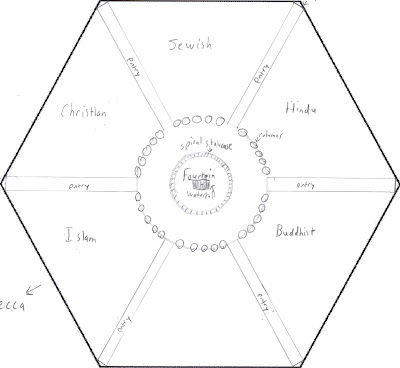Our proposal for a Universal Sacred space would take the form of a large, two level, glass roofed hexagonal structure located atop a hill. Each outer wall would be approximately 250 feet long, yielding a total square footage of approximately 160,000 (per floor.) This is approximately the size of a large North American “megachurch.” The great deal of open space in the design, would allow for several thousand to attend the structure at once.
At the apex of each corner there would be double doors decorated with images or wisdom from the two religions on either side of the corridor leading into the common area. The corridors making up the six entrance pathways would be the only permanent walls within the inside of the building. Messages of “Peace, Understanding, and Kindness” would be translated into dozens of languages to and be placed in the tile of the floors to remind visitors of the concept behind our facility. Our structure would encourage each of the represented religions to place their own iconography, religious artifacts, paintings, murals, etc. along the wall space bordering their own rooms (as defined below) to illustrate their own faith’s history.
There are five major world religions: Christianity, Islam, Judaism, Hinduism, and Buddhism. Correspondingly, five of the large trapezoidal spaces created would house a temple, cathedral, mosque, or other place of worship appropriate for the religion within it. The sixth trapezoidal space would be dedicated for religions that are not represented to appropriate during festival/worship times for that religion. In the center of the six empty trapezoidal halls would be a circular gathering area ringed in columns (5 per section, so 30 in all) that would be decorated with olive branches around the capital and base. Each column would have a different message or decoration, with the theme being a representation of that religion (e.g. the five columns outside the Islamic worship section would have the five central tenets of Islam carved into them.) This would remind the faithful of their obligations, while simultaneously educating those of other faiths who chose to examine the thirty pillars. At the center of the gathering area would be a large circular reflecting pool, and a large waterfall fountain that extends down from the second floor. A large winding spiral staircase would encircle the fountain and lead visitors up to the second floor. Windows would ring the upper rim of the walls and be decorated appropriately for each religion (stained glass windows in the Christian area for example) to allow natural light into the open trapezoidal rooms of the building during the day.
The second floor of our space would largely be comprised of gardens, hedge mazes, rock sculptures, artificial streams and other naturalistic themes. There would be plenty of room to incorporate small shrines at the end of these roaming pathways, appropriate for worship or quiet meditation. At the six corners would be spaces for each religion to place a large icon, dome, steeple, or other identifiable architectural construction that would represent that religion’s wishes. The sixth, multi-use room’s corner would have a large open area to install icons for the variety of religions that would inhabit the multi-use space.
The ceiling would be constructed of a series of cantilevered eaves (similar to the Forbidden City) but instead of wood, glass and solar panels would be used to create designs and shaded/sun zones within the garden pathways while simultaneously helping to provide electricity for air conditioning and lighting for night time services. A huge glass dome on the six sided pendentives would cover the center section of the building, where the stairs/fountain/waterfall are and be constructed of etched glass that would cast picture-shadows along the floors of the commons area and garden as the sun pathed during the day. These etchings would reflect the iconography of the various religions that worship regularly within the structure. The areas where the second floor steeples, icons, etc. are would be left open and uncovered by the large cantilevered glass ceiling as well.
The structure itself would be placed on a hill, as many religious houses are, with parking and picnic areas below and flat (to make them wheelchair accessible) winding paths (representing a pilgrimage) that lead up to the structure. Along these paths would be small monuments and plaques that would cover the history of the world’s religions, including ones long past, such as the ancient Egyptians, Greeks, African, Australian, and American tribal religions, Mayans, etc. much like a miniature historical tour. This would be to make people aware and cognizant of the diversity of religion, culminating when they get into the building itself and see the “Peace, Understanding, Kindness” etchings in the floors as well as the iconography, paintings, etc. lining the walls of the entry ways. A second, smaller, duplicate structure would be located nearby and serve as a library and repository of knowledge. Additionally, it could be used as a historical museum for the religions to provide a focused representation of their respective pasts and intended futures.
The central idea behind our proposal is to create a space that can be appropriated initially, that is largely made up of free space so that worshipers can adapt it more easily to their needs. As these needs change over time, altars, icons, objects, seating, anything really, could be added to the spaces they inhabit during their worship. A sense of fluidity is needed, so that the spaces could be filled as necessary and wanted, with permanent tokens of wisdom left behind etched into the walls of the six long entry corridors and upon the thirty pillars ringing the common area. The entire second floor would be an incarnation of the natural world, and the glass ceiling would bring worshipers in touch with the sun and the stars, essentially allowing the natural world inside.




